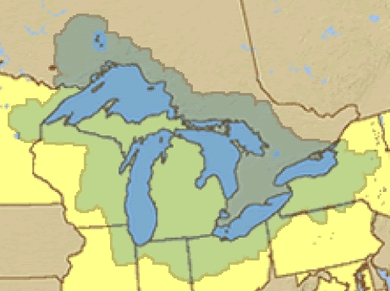A wall's being built along the northern border of the U.S.


And this isn't a wall promulgated by Homeland Security. It's not about people trying to get into the U.S. No this wall is aimed at keeping some states from getting resources that other states have. We're talking here about various "United States" states.
It's not a physical wall that's being erected around the Great Lakes, but it could be impenetrable. It's a binding agreement on the use and exportation of water from the Great Lakes Basin. Seems the states of that region are suspicious more arid states, say in the Great Plains and the Southwest, might make a play for Great Lakes water. Just last year the Southeast, which normally has plenty of water and humidity to match, had severe drought in some areas.
Wisconsin recently became the fifth state to ratify this water pact. The agreement needs the ratification of three more states: Michigan, Ohio and Pennsylvania. Then it needs federal approval to go into effect. It would ban any long-distance diversion of Great Lakes Basin water and lays out goals for sustainable water use by the states on the lakes. No pipeline to Vegas, Phoenix or Dallas.
There's another country along the lakes and soCanadian media is watching this whole effort. And their own environmental minister is calling for conservation of the lakes' water.
GREAT LAKES ARE GREAT SUPPLY OF WATER.
It's been estimated that one-fifth of all fresh water on the earth is contained within the Great Lakes and St.Lawrence Seaway that drains them to the Atlantic. The U.S. Geological Survey tracks the fluctuation of the lakes, four of which are near historical low levels right now. Last year Lake Superior at one time was at its lowest level in 77 years. Then it began to refill. However, the lake levels are always changing, never stable. Many "lakeshore" buildings and resorts now find themselves far from water. Fears of dry lake beds along the Milwaukee and Chicago waterfronts are part of what's sparked the current Great Lakes compact. NOAA also tracks water use and loss in the Great Lakes Basin.
I recently blogged about American and Canadian research and information-sharing around the Great Lakes. If the Great Lakes compact goes into effect we can expect other areas to follow suit and some of the heavily populated and arid states may start to look around for insured supplies. California, Nevada, Texas, Arizona, Colorado.
The water issues will not dissolve, but they may precipitate some serious political moves. And they will encourage cleantech aimed at water re-use, recycling and purification. Australia's planning a solar-powered desalination plant. Israel uses desalination on a relatively large scale already. AND THAT'S NOT ALL...
Chicago's rightfully known as the "Windy City." So here's a summary of the first big conflab to look at using the considerable wind resources of the Great Lakes region.